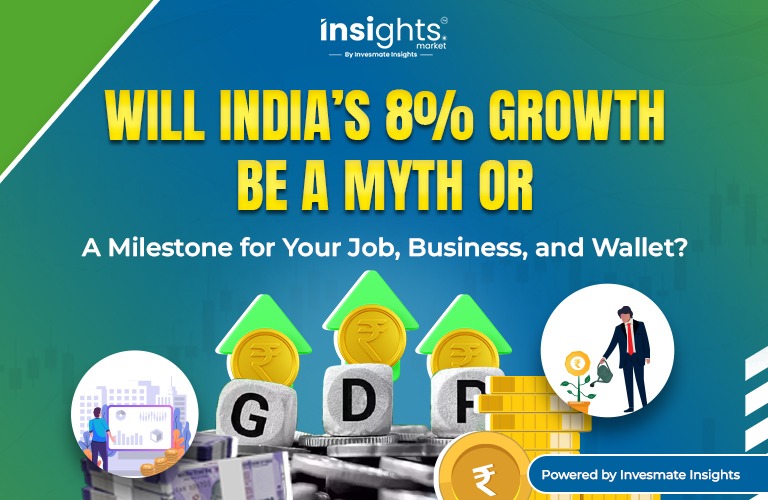![]()
Ever wondered if India can hit that ambitious 8% GDP growth target? It’s not just a number—it’s at the heart of India’s mission to become a developed nation by 2047, under the vision of Viksit Bharat. But how close are we to that goal?
Let’s break it down. We’ll explore what’s fueling India’s rapid rise, what roadblocks lie ahead, and most importantly, how this impacts you, your job, your business, and your wallet.
India’s Growth Story: What’s Going Right?
India is on the move. As the 5th largest economy in the world, it’s poised to jump to 4th by 2025—and maybe even 3rd by 2026 or 2028.
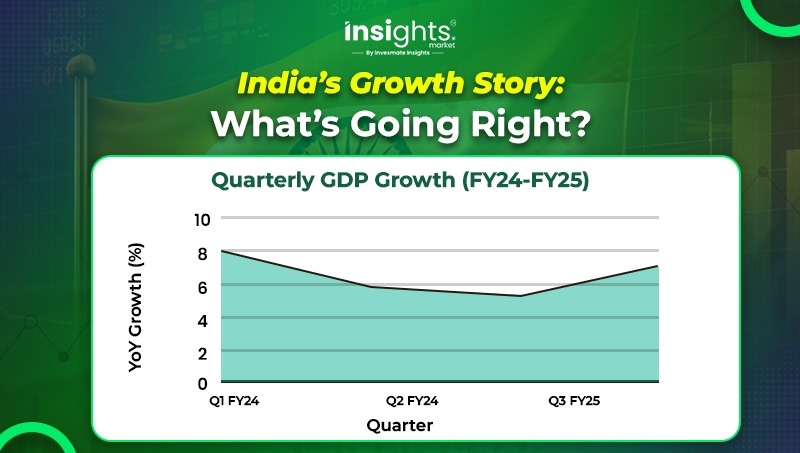
Read Now: India FY25 GDP Growth 2025: Rollercoaster Year of Resilience, Surprise, and Economic Recovery
So, what’s powering this momentum?
1. Consumer Power: India Loves to Spend
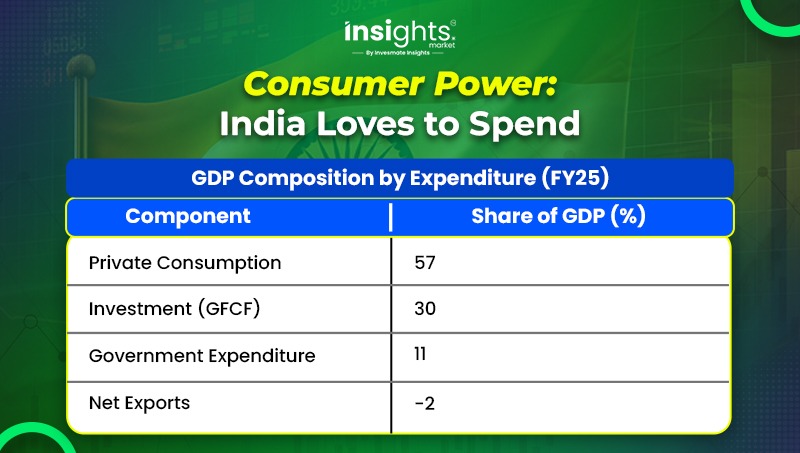
Picture a buzzing bazaar—people shopping, eating, living life. That’s India’s domestic consumption, which makes up over 56% of our GDP. And it’s growing fast.
What’s driving it?
- A booming middle class
- Youthful energy—52% of India is Gen Z or millennials
- Income-tax cuts leaving more money in people’s hands
But there’s a flip side: urban spending is cooling, and many rural and low-income households aren’t feeling the growth. If we want to maintain 8% growth, everyone needs a seat at the table.
2. Investment Surge: Public and Private Money at Work
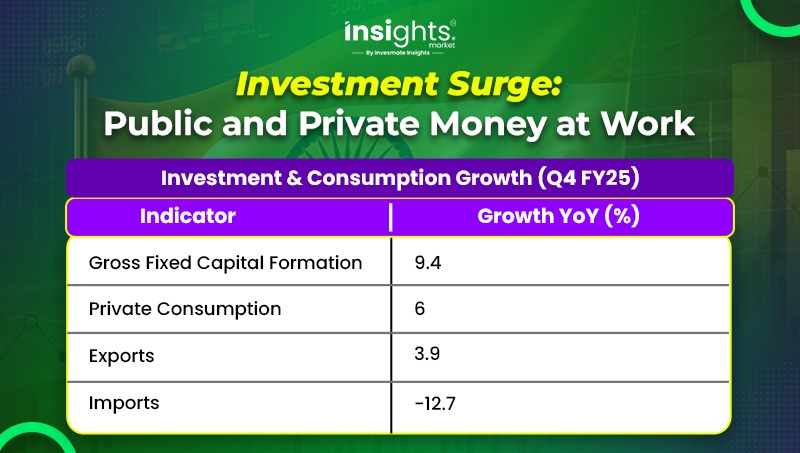
India’s infrastructure push—roads, rail, ports, green energy—is massive. The government is investing heavily, hoping to spark private sector investment.
Meanwhile:
- India has received over $1 trillion in FDI since 2000
- Domestic businesses are more profitable than ever
- IPOs are hitting record highs
But to truly hit 8%, private investments must take center stage, not just government spending.
3. Digital India: Tech Is Changing Everything
From UPI payments to AI startups, India’s digital economy is booming. It already contributes around 12% of GDP, and is almost 5x more productive than other sectors.
Fun fact: UPI processed ₹260.6 trillion in FY25!
India also has the third-largest startup ecosystem in the world. This digital leap could power 20% of GDP by 2030.
Still, we must ensure tech-led growth doesn’t leave people behind. Jobs must grow with innovation.
4. Young Population & Pro-Reform Push
India has a median age of just 29—one of the youngest populations globally. This “demographic dividend” is a massive advantage if we create the right jobs.
Reforms like GST and ease-of-doing-business policies have laid the groundwork. Now, we need to build on that momentum with skills, jobs, and innovation.
The Hurdles: Why 8% Won’t Be Easy
Despite our strengths, hitting and sustaining 8% growth won’t be a smooth ride. Here’s what’s holding us back:
1. Old-School Problems Still Exist
2. Jobs & Skills Crisis
This one’s big: 83% of the unemployed are under 30. Shockingly, only 15% of the workforce has formal vocational training, and nearly 90% work informally.
If India wants real, sustainable growth, it must create millions of formal, well-paying jobs—especially for the youth and women.
3. Inflation: A Quiet Threat
While inflation seems low—3.16% in April 2025—“core inflation” (excluding food and fuel) remains sticky. High inflation erodes purchasing power and discourages investment.
A stable price environment is non-negotiable for long-term growth.
4. Global Risks & Domestic Inequality
Trade tensions, geopolitical conflicts, or a global slowdown can hit exports and investment flows hard.
At home, income inequality remains stark. Low per capita income and uneven development slow down consumption and widen the wealth gap.
Current Geopolitical Risks: Strait of Hormuz and India’s Oil Security
Recent tensions in the Middle East, especially around the Strait of Hormuz—a vital route for about 30% of the world’s oil trade—have raised concerns about the security of India’s energy supplies.
India imports roughly 40% of its crude oil from Middle Eastern countries through this strait, with 2.1 million barrels per day coming via this route in early 2025.
However, India has significantly diversified its oil import sources in recent years, increasing purchases from Russia, the US, and other regions. According to Oil Minister Hardeep Singh Puri, this strategy has made India less vulnerable to disruptions in any single supply route.
While any escalation in the region could impact global oil prices and market sentiment, India’s flexible sourcing and policy shifts have improved its energy security.
Read Also: The Israel-Iran Conflict: What It Means for Your Wallet, Fuel Prices, Stocks, and India’s Economy
5. Weak Links: Manufacturing & Agriculture
Services are India’s growth engine, but they don’t create enough jobs for the less educated.
- Manufacturing is stuck at 14–17% of GDP
- Agriculture employs nearly 50% of the workforce but contributes just 16% to GDP
To hit 8%, India needs a better balance—more industrial jobs and modernized farming.
So, What Needs to Change?
Getting to 8% growth—and staying there—requires a focused, multi-pronged approach:
Bold Reforms
Land, labor, and capital markets need serious upgrades to improve productivity and attract investors.
Job Creation
Formalize work, invest in vocational training, and boost female workforce participation.
Investment Push
Link public investment to private growth. Sign trade deals. Expand exports beyond just IT services.
Financial Health
Maintain sound fiscal and monetary policy. A stable economy builds long-term investor trust.
Read Also: RBI’s Bold Rate Cuts & CRR Slash: What It Means for Your Loans, Savings, and Wallet in 2025
Digital for All
Digital infrastructure must reach rural India. Don’t just build apps—build inclusion.
Inclusive Growth
Focus on lagging states. Improve health, education, and local infrastructure to reduce regional disparities.
The Verdict: Is 8% Just a Dream?
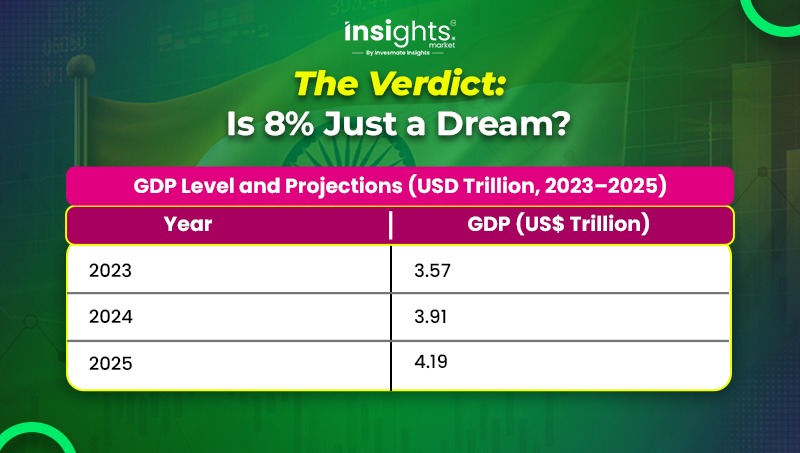
Right now, economists expect India to grow to stay at 6.2–7.0%. That’s good, but not enough to meet the 2047 Viksit Bharat vision.
The good news? India has powerful growth engines:
- Rising consumption
- Digital transformation
- Strong infrastructure investment
- Young and energetic workforce
But the challenges—jobs, reforms, inflation, inequality—are too big to ignore.
With bold action and smart policy, 8% is not a fantasy. It’s a tough, but achievable milestone.
What do you think? Is India on the right path? Will we hit 8%?
Drop your thoughts in the comments. Let’s start a real conversation about our economy’s future.
FAQs
Experts say it’s ambitious but achievable with major reforms and investment.
Key hurdles include outdated regulations, labor and land market issues, low formal job creation, inflation risks, global economic uncertainties, and persistent inequality. Structural reforms and inclusive growth are necessary to overcome these barriers.
Higher growth can generate millions of new jobs, raise average incomes, and reduce poverty. However, the quality of jobs and ensuring benefits reach rural and low-income households are equally important for truly inclusive development.
Consumption, infrastructure, digital tech, manufacturing, and agriculture.


